A Short History of Ornamental Wood Flooring
No one knows, of course, who first had the idea to lay down an ornamental wood floor, but the designs used to create ornate wood floors are as old as human history itself. From the earliest times, we have decorated our objects, buildings, and even ourselves, finding inspiration in nature, from the shapes of crystals to the symmetry of the veins on a leaf radiating from a central stem.
The traditions of the classical arts that stretched from the Egyptians through the romans, largely forgotten in Europe, remained in the universities of the Byzantine Empire.
When they took Constantinople in 1453, the Ottomans closed the universities of the Byzantine Empire, and many of their Greek scholars immigrated to Italy. With them came ancient texts and a scholarly tradition that helped fuel the Renaissance.
The Renaissance period in Italy was one of the highpoints of ornamental design, as artisans produced exquisite ornate marble floors in parquetry and marquetry designs. Similar designs are seen throughout the history of wood flooring. Renaissance artisans also produced elaborate wooden panels. It is possible that ornate wood floors were created during this time in Italy, or even earlier, but being subject to wear, fire, and water damage it is hard to find examples more than 500 years old anywhere in the world.
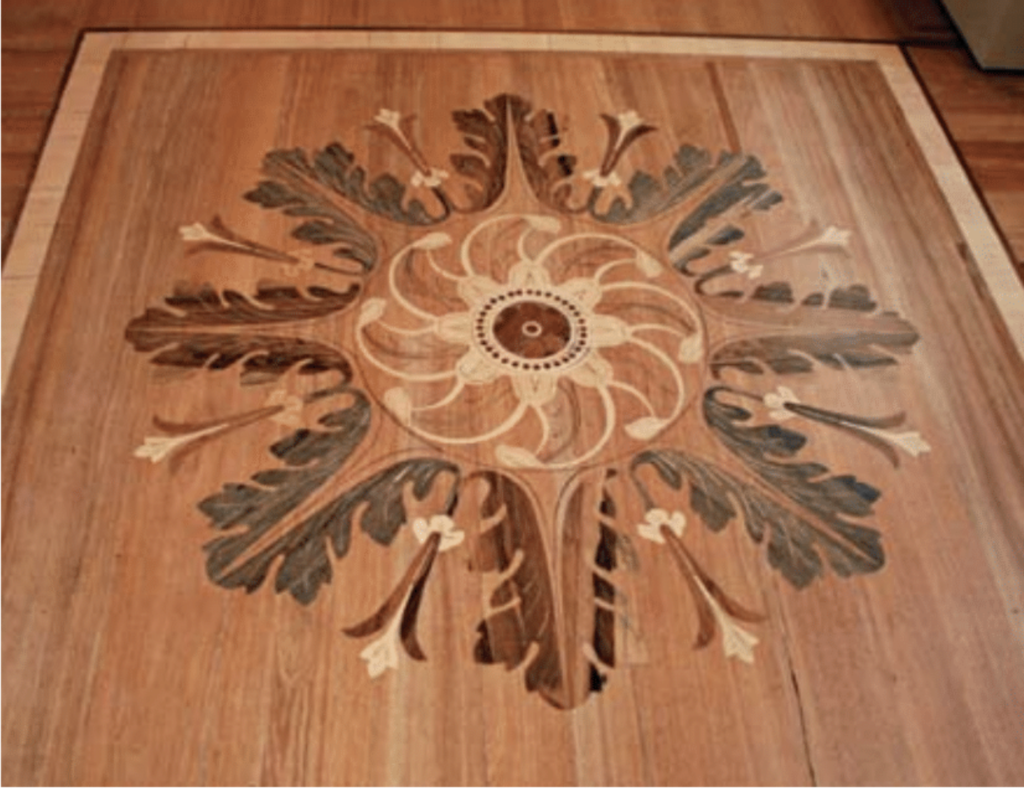
Abstracted and formalized acanthus leaves have been a common ornament for thousands of years. They are traditional in bas-relief carvings and possible to render two-dimensionally in flooring.
The French Influence
 Although Italian artisans possessed the skills to produce ornate wood floors, French artisans seemed to lead the way. Ornamental woodwork was generally reserved for areas of higher architectural importance like the ceiling. The ballroom at Fontainebleau Palace was created with just such an elaborate wooden ceiling. In 1547, architect Philibert Delorme went a step further and created a matching ornamental wood floor; it’s now considered the oldest remaining significant ornate wood floor in the world.
Although Italian artisans possessed the skills to produce ornate wood floors, French artisans seemed to lead the way. Ornamental woodwork was generally reserved for areas of higher architectural importance like the ceiling. The ballroom at Fontainebleau Palace was created with just such an elaborate wooden ceiling. In 1547, architect Philibert Delorme went a step further and created a matching ornamental wood floor; it’s now considered the oldest remaining significant ornate wood floor in the world.
About a century later, the Palace of Versailles, which like Fontainebleau had elaborate wood floors, played a pivotal role in popularizing ornate wood flooring. To consolidate his control, the king of France required nobles to stay at the palace for part of the year, and they began copying Versailles’ wood floors at their own estates. Ornate wood floor designs quickly came into vogue and spread throughout France and beyond.
Nobility from other countries were also impressed. England’s Queen Henrietta Maria installed parquet floors in Somerset House in about 1650 after her visit to Versailles. In 1717, czar Peter the Great stayed at Versailles, which became an inspiration for his own Peterhof Palace. That and other Russian palaces built in the same period house some of the most beautiful ornate wood floors in the world.
Flooring in America
In the United States, ornate wood floors were uncommon in colonial times. Thomas Jefferson (who had been ambassador to France before his presidency) installed parquet floors at Monticello. Despite Jefferson’s influence, most homes built prior to 1870 had softwood plank floors of varying widths. Sometimes the floors were painted to make them easier to clean. During the Victorian era, the mass production of parquet wood flooring began. It was commonly installed as a border because oriental carpet covered the center of the room.
American architecture, and floors, trended through a number of fashions after the Victorian era. Largely, custom ornate floors were limited to the homes of the wealthy, while middle-class floors were generally plain or decorated with simple elements such as borders. It was an age of great change, and the mass production of the industrial age made inroads in Victorian flooring. “Wood carpeting,” a thin parquet glued to a heavy canvas back, came in vogue. It was mainly installed by cutting sections from a roll and top nailing with numerous tacks.
Parquet fell out of fashion in the early 20th century, but picked up again in the 1950s with the introduction of cheap tiles that could be directly glued to concrete with asphalt adhesive. By the 1970s, the price of parquetwas competitive with carpet, and contractors installed it as fast as they could. The shortcuts taken by some of them gave parquet a bad name, which eventually combined with changing fashion to help it fall from favor.

One of the oldest surviving examples of American ornate wood floors is at Monticello, where Thomas Jefferson designed parquet with a center square of cherry framed in beech. The grain direction of the center squares alternate, and the floors were finished with beeswax.
Ornamental Flooring Design
 Most ornate designs contain several species of wood, and the differences in color and texture help to make the design stand out. However, mixing different species can be challenging because each species has its own characteristics. It’s important to combine only those wood species whose characteristics are similar. Softer woods may show more wear than the harder species surrounding them. Each species reacts differently to moisture changes, which can cause overwood (a noticeable difference in height between abutting boards), gaps, or cupping. Some species may discolor surrounding boards of different species during sanding and finishing. For example, placing bloodwood, a bright red South American wood, next to maple can discolor the maple when the bloodwood is sanded. As long as you pay close attention to details, there is no need to worry. As the saying goes, measure twice and cut once.
Most ornate designs contain several species of wood, and the differences in color and texture help to make the design stand out. However, mixing different species can be challenging because each species has its own characteristics. It’s important to combine only those wood species whose characteristics are similar. Softer woods may show more wear than the harder species surrounding them. Each species reacts differently to moisture changes, which can cause overwood (a noticeable difference in height between abutting boards), gaps, or cupping. Some species may discolor surrounding boards of different species during sanding and finishing. For example, placing bloodwood, a bright red South American wood, next to maple can discolor the maple when the bloodwood is sanded. As long as you pay close attention to details, there is no need to worry. As the saying goes, measure twice and cut once.
The layout of wood flooring must take the focal points of the room into consideration, but you also have to consider the placement of furniture. It goes without saying that a decorative wood inlay is wasted if it’s hidden under a sofa or chair. At the same time, furniture and flooring borders can be used to define an area such as a dining room without having to enclose it with walls.
Scale and Proportion, Harmony and Rhythm
The design of the floor should take into account the appropriate scale and proportions of the elements of the room while at the same time maintaining harmony between them. For example, a medallion 7 ft. in diameter might overwhelm a 12-ft.-wide dining room.
Harmony isn’t easy to describe. The effect is a subjective, I-know-it-when-I-see-it one. One way to describe it is to say that the elements work together. Harmony is achieved through the blend of wood tones and flooring patterns. The patterns can be subtle or bold, as long as there’s a balance between the elements.
Rhythm is important to harmony and is created by the recurrence of color, size, or shape in the elements of the design. The eye is able to relax when it recognizes a pattern, even when the overall look is complex. Slight variations maintain visual interest, while using contrasts in color, size, or pattern to bring the eye toward focal points.
Ornate floors don’t exist by themselves—they also play a role in the room as a whole. The level of detail in the floor should resonate with that of the room: You wouldn’t install a palatial floor in most residences, for example. One way for the flooring to complement the room is to use its pattern to pull the eye toward focal points such as medallions and borders. Most elaborate designs help to maintain visual interest and guide the eye through various levels of focal points in the room. Creating a hierarchy among focal points prevents confusion, while employing the subtle use of dissimilar elements helps to maintain visual stimulation.

Combining several species of wood in one floor helps to accentuate the pattern.
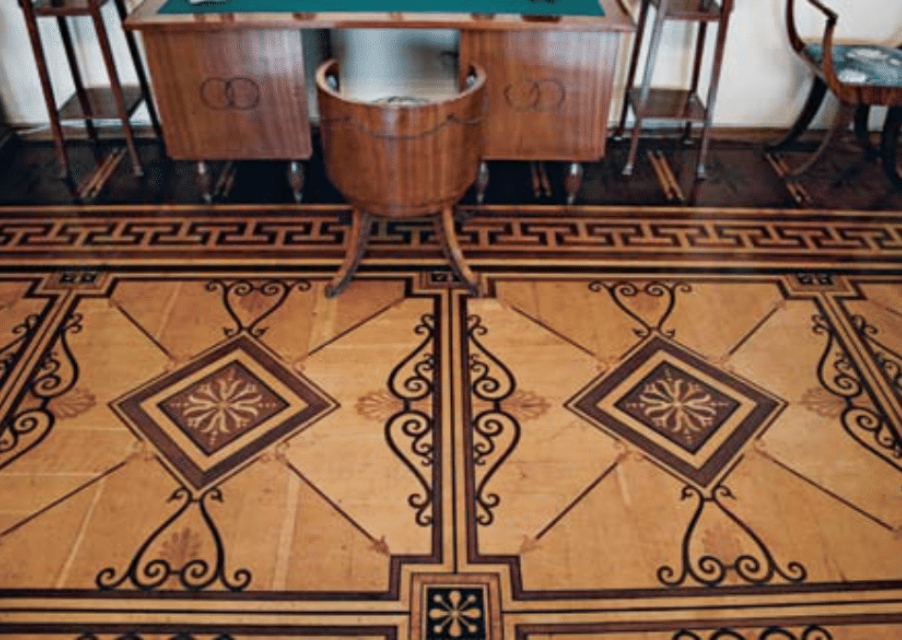
The most ornate sections don’t usually continue all the way to the wall. Borders and aprons around the edges of a room, where furniture is likely to cover the work, are typically simpler than the flooring in the field.
Elements of Ornamental Flooring
Most ornate wood floors contain certain basic elements, though by no means does a floor need all of them. The main area of the floor is the field, which can be composed of parquet designs or straight flooring. A single board called an accent strip or feature strip often surrounds the field. This strip is typically made from a wood species whose color contrasts with the field. Its width is generally narrow relative to the proportion of the floor. Borders are decorative flooring bands that define an area such as the field of the floor. They may have a pattern that continues around the room uninterrupted or divided into segments.
PROPORTION IS KING
Even the most beautifully wrought ornate work will look wrong if it’s out of scale with the room. The medallion in the drawing at near right is proportional to the field of the floor. The one in the drawing at far right may be dramatic but it dwarfs the space. It’s hard to have a sense of what will work in a particular room without drawing the layout on the floor first. In the end, it is the client’s preferences that matters.
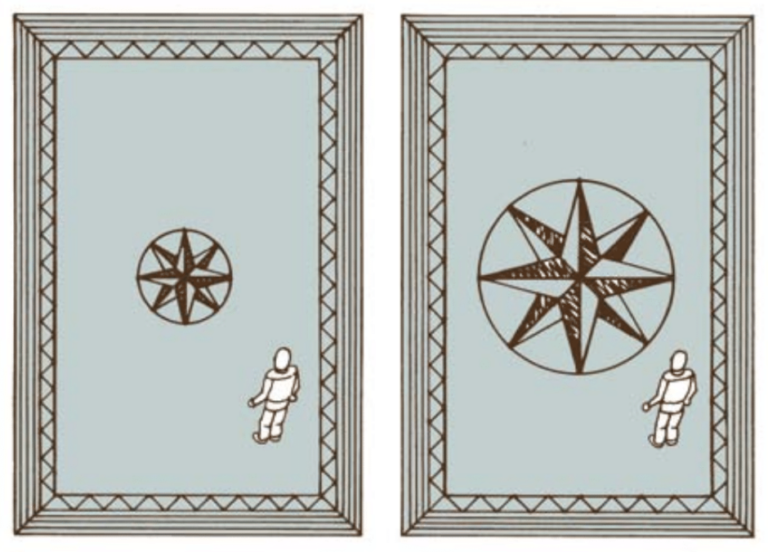
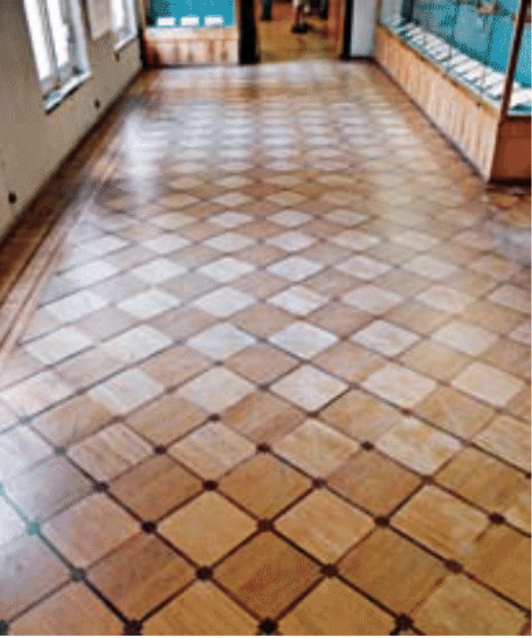
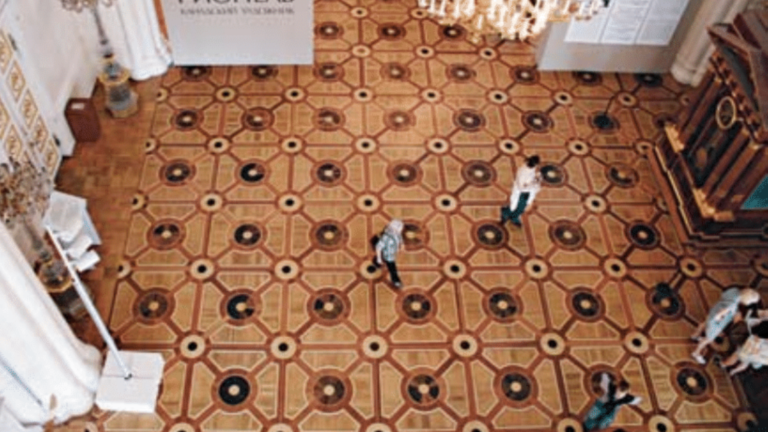
Corner blocks divide border segments where they meet at corners. Not only do they spice up the border, but they’re also helpful to the installer. Without the blocks, whatever pattern the border takes would have to meet up perfectly at the corners. For this to happen, the field would have to be sized perfectly in both dimensions to a multiple of the pattern’s repeat. And the pattern would need to be installed with no variations. in the real world, that’s very hard to accomplish.
If you eschew corner blocks and want to show off your skills by having the border go around the corners continuously, V-blocks, or center blocks, are a more subtle way to make the joints work out. V-blocks are decorative elements placed midway in the border’s length. The border is first joined at the corner, and then installed back toward the middle. The size of the blocks can be varied to work with however the border pattern falls.
Aprons are an outside band of flooring that tie in the entire ornate design to the walls of the room. Aprons are usually relatively plain, often just strip flooring in keeping with their function of picture framing an ornate field. To make it easier to sand the floors, it’s a good idea to make aprons at least wide enough so that a big floor sander fits on the apron without overlapping the ornate work in the border and field.

Many elements of an ornate wood floor are also found on oriental carpets. The field (A) is the main area of the floor and can be composed of parquet designs or straight flooring. A medallion (B) is sometimes inserted as a focal point of the room. Surrounding the field may be a border (C) with accent strips (D), corner blocks (E), V-blocks (F), and an apron (G).
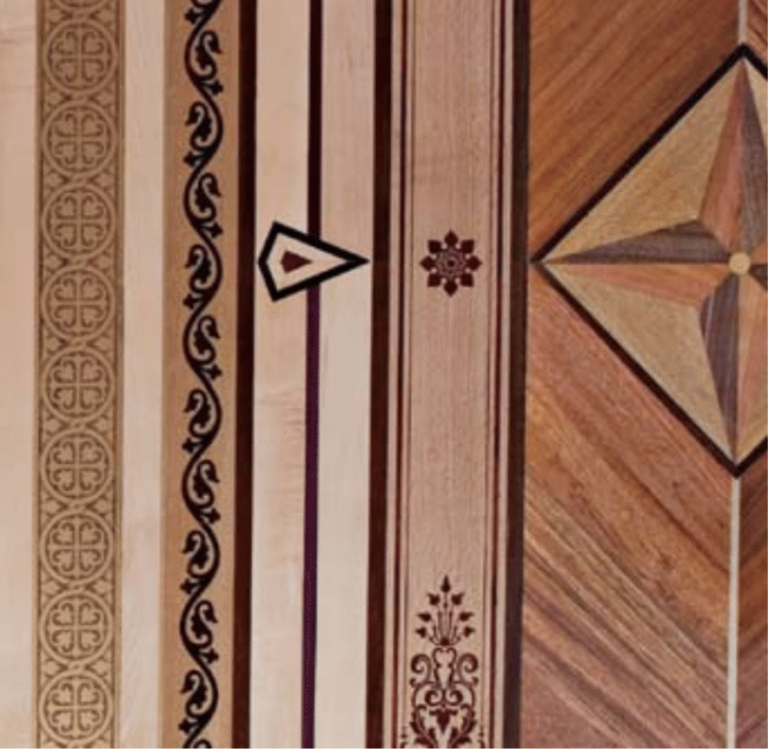
V-blocks break up long borders, and provide an opportunity to adjust patterned borders to join at the corners.

Aprons are typically plain and frame the border and field.
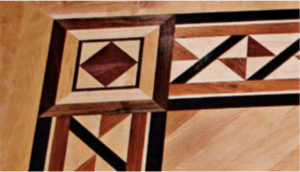
Corner blocks add another element, but they also save the installer from having to create a border whose pattern has to match perfectly at the corners.

Accent strips are often of a contrasting wood and outline the field of a floor.

Borders provide a visually appealing break between the field and the apron.
